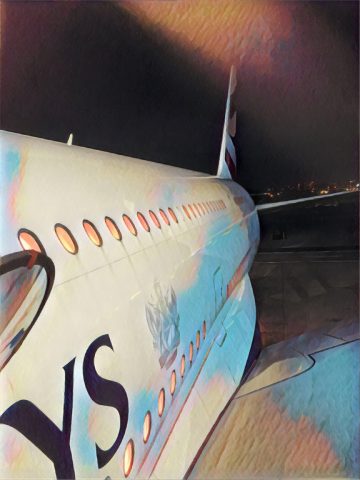 I’ve long held the belief, articulated by author Ursula Le Guin in her sci-fi novel The Dispossessed, that the only real way to close the loop on travels and explorations is to come home and share your discoveries and adventures. Which for me means the next logical step is to actually bring people from your origin point to see and experience the places that resonated.
I’ve long held the belief, articulated by author Ursula Le Guin in her sci-fi novel The Dispossessed, that the only real way to close the loop on travels and explorations is to come home and share your discoveries and adventures. Which for me means the next logical step is to actually bring people from your origin point to see and experience the places that resonated.
My husband’s family are a clan of adventurers: both his parents lived overseas in their youths, and they continue the tradition today through a range of world travels. We’ve already been with them on three cruises to destinations as varied as Honduras, Alaska, Vietnam, and Taiwan. But I’ve never gone with them to any of the spots that first sparked my interest in world travel.
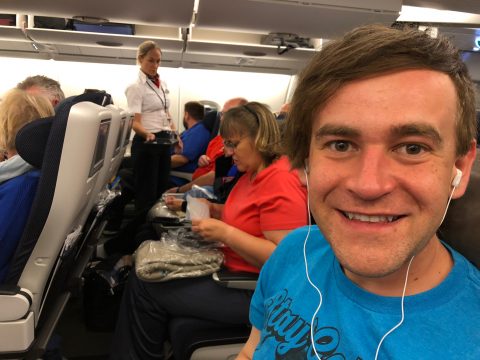 It’s been a nostalgia-filled year already: we’d taken two more of our nieces and nephews on a trip to Europe in the spring; we’ve begun the planning process of starting a family; and, for me, having recently unearthed and scanned some old photo albums, I’ve thought a lot about legacy and continuity. Heck, I’m even working on a new (fictional) piece of writing, a coming-out romance set in the U.K. in the 1980s. Stay tuned, Wander the Rainbow readers.
It’s been a nostalgia-filled year already: we’d taken two more of our nieces and nephews on a trip to Europe in the spring; we’ve begun the planning process of starting a family; and, for me, having recently unearthed and scanned some old photo albums, I’ve thought a lot about legacy and continuity. Heck, I’m even working on a new (fictional) piece of writing, a coming-out romance set in the U.K. in the 1980s. Stay tuned, Wander the Rainbow readers.
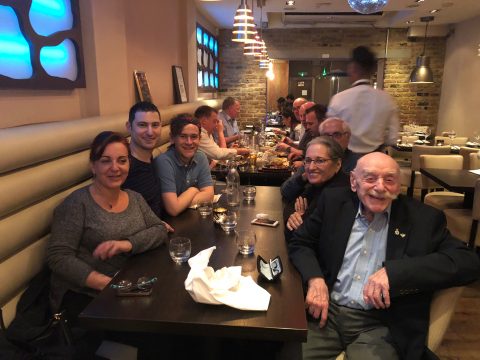 We all gathered at SFO on Monday evening to kick off our voyage. The British Airways A380—an aircraft I’d only flown once, a few years back—lumbered to our departure gate. Strong tailwinds over the Atlantic meant a shorter than usual flight from the West Coast to the U.K., about nine hours, still plenty of time to get the usual so-so sleep and watch the odd movie. At this point, arriving at Heathrow has become a routine ritual to inaugurate an overseas trip—so much so that I already have the app for the Heathrow Express on my phone. Travel tip: tickets are cheaper if bought for the first time through the app.
We all gathered at SFO on Monday evening to kick off our voyage. The British Airways A380—an aircraft I’d only flown once, a few years back—lumbered to our departure gate. Strong tailwinds over the Atlantic meant a shorter than usual flight from the West Coast to the U.K., about nine hours, still plenty of time to get the usual so-so sleep and watch the odd movie. At this point, arriving at Heathrow has become a routine ritual to inaugurate an overseas trip—so much so that I already have the app for the Heathrow Express on my phone. Travel tip: tickets are cheaper if bought for the first time through the app.
It was another quick overnight in London… which meant another dinner gathering with members of the Lightman clan and our multi-generational friendship. This time, though, the big difference was that both my Mom and I were there at the same time—the first time that’s ever happened. It made for even more nostalgia: this whole shebang began with two people (my parents) on a date, almost exactly fifty years ago, in this grand old dame of a city. Oh, yeah, and we managed to have a meal of killer Indian food, naturally. This is London, after all.
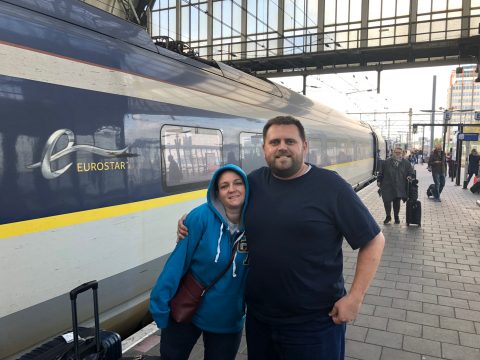 Next morning, six of us—Mathew, me, his parents, and his brother plus fiancé, hopped a Eurostar at St. Pancras, another well-worn next step in travels in this part of the world. But we were on a new trajectory for the now almost quarter-century-old trans-Channel rail line, one that previous required a transfer but can now be undertaken in a single three-and-three-quarter hour journey: Amsterdam.
Next morning, six of us—Mathew, me, his parents, and his brother plus fiancé, hopped a Eurostar at St. Pancras, another well-worn next step in travels in this part of the world. But we were on a new trajectory for the now almost quarter-century-old trans-Channel rail line, one that previous required a transfer but can now be undertaken in a single three-and-three-quarter hour journey: Amsterdam.
This city’s also a familiar groove for us: Mathew had visited with one if his best friends some three years back, and I’d joined them for the final days of that adventure. I’d also been there on my big world trip… but, for me, the connection to the Dutch capital goes back even further: it was a frequent stopover point when we lived in the Middle East for three years when I was a boy. Its combination of old-world grandeur and modern-day liveliness is one I rediscover and appreciate every time I return.
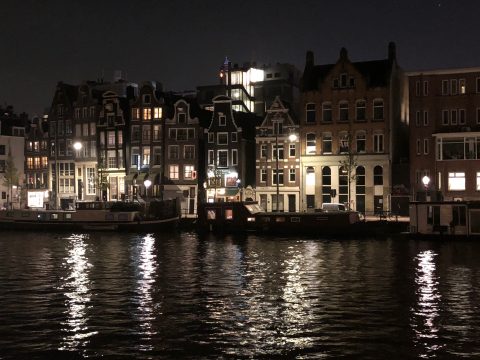 “Looks a bit like Disneyland,” I said to Janelle, Mathew’s brother’s fiancé, as we strolled the canals fronted by those flat-faced brick townhomes. No accident, that, as I discovered in my wanderings around Europe over the past decade: theme park Imagineers have been combing Europe for decades in search of the sublime aged, walkable intimacy that’s a centerpiece of its towns and cities. For many of us who’ve grown up in North America, nostalgia for such places therefore has gone in reverse, having been ignited by visits to themed attractions that echoed when we saw the real thing years later. I actually think that’s a good thing, as we travelers can experience sentimental reminders of places as we first experience them, in person, as adults.
“Looks a bit like Disneyland,” I said to Janelle, Mathew’s brother’s fiancé, as we strolled the canals fronted by those flat-faced brick townhomes. No accident, that, as I discovered in my wanderings around Europe over the past decade: theme park Imagineers have been combing Europe for decades in search of the sublime aged, walkable intimacy that’s a centerpiece of its towns and cities. For many of us who’ve grown up in North America, nostalgia for such places therefore has gone in reverse, having been ignited by visits to themed attractions that echoed when we saw the real thing years later. I actually think that’s a good thing, as we travelers can experience sentimental reminders of places as we first experience them, in person, as adults.
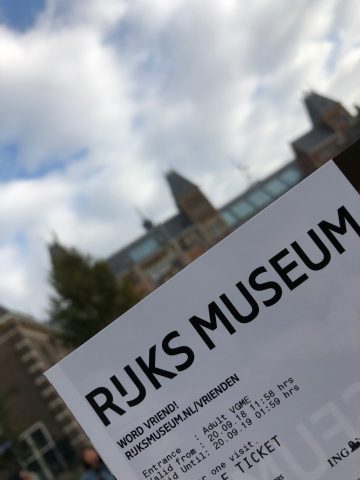 For me, however, Amsterdam came with another mission: both of the last times I was here I’d missed the Rijksmuseum, which was in the middle of a decade-long remodel that finally concluded a few years back. I hopped the newly-completed, super-efficient central line of the Amsterdam Metro out to Museumplein, stood in a refreshingly short queue, and, in front of the iconic IAmsterdam sign, snagged a ticket for a morning with the Dutch masters.
For me, however, Amsterdam came with another mission: both of the last times I was here I’d missed the Rijksmuseum, which was in the middle of a decade-long remodel that finally concluded a few years back. I hopped the newly-completed, super-efficient central line of the Amsterdam Metro out to Museumplein, stood in a refreshingly short queue, and, in front of the iconic IAmsterdam sign, snagged a ticket for a morning with the Dutch masters.
The remodel of the museum is impressive: the central atrium of the massive state museum is now enclosed in glass, and has become the new entrance to the facility. The previous entrance, a grand, stained-glass lobby, is now the access point for what many of us come to this place to experience: masterworks of the Dutch Golden Age in the 1600s.
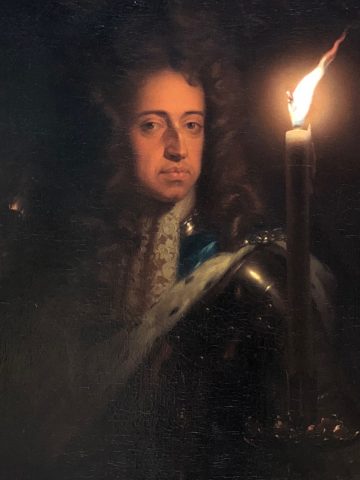 Rembrandt’s The Night Watch is, of course, one of the place’s signature pieces, and the crowds in front of it echoed those I’d experienced mobbing the Mona Lisa. But unlike Da Vinci’s not-huge signature work, The Night Watch is flippin’ massive. As with Mona, though, it’s another work whose name was given to it years later.
Rembrandt’s The Night Watch is, of course, one of the place’s signature pieces, and the crowds in front of it echoed those I’d experienced mobbing the Mona Lisa. But unlike Da Vinci’s not-huge signature work, The Night Watch is flippin’ massive. As with Mona, though, it’s another work whose name was given to it years later.
As a onetime aspiring filmmaker, though, the old Dutch masters offer another enticement: the brooding hues of Rembrandt and Vermeer (and many others), no doubt influenced by the moody Dutch climate, meant that the interplay of light and shadow are an extra-big deal than the more luminous works of artists farther south. Cinematographers study how lighting and shadows are depicted in these works. Also, in an era when art was so dedicated to royals, nobles, and the Church, many of these Dutch painters captured scenes of ordinary people going about their workaday lives. It sort-of fits with a place that practically invented the modern market economy, and whose tolerance in an intolerant age led to welcoming the pre-American Puritans and—in later centuries—legalizing and regulating cannabis and prostitution. In the Netherlands, everything goes, yet in remarkably orderly fashion.
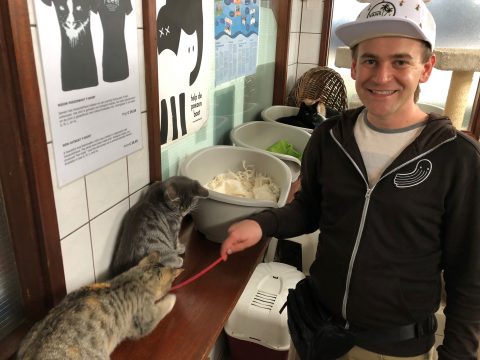 Later that day, Mathew and I indulged another fixation: at this point we’ve been to cat cafés on three continents, and as proud caretakers of a cat and dog of our own, we seek out such spaces wherever we can. Well, Amsterdam’s got its own entrant that even predates the Asian-originated cafés: a canal boat that serves as animal shelter and tourist attraction. We arrived at De Poezenboot not long before they were set to close—cats being cats, the place is open to the public only two hours a day. Pro tip: arrive when it opens. After navigating the short line, we entered the floating structure, where cats of all shapes and sizes do their thing. A few were still in carriers, recent rescues that were still acclimating to their new surrounding. Though one burly, longhaired tabby—echoing our own fearless, independent Khaleesi—was meowling loudly until the place stopped admitting visitors, at which point he and his compatriots were let loose in the facility. While the other cats cautiously stepped out of their pens, he bolted like a racehorse and proceeded to run laps around the place.
Later that day, Mathew and I indulged another fixation: at this point we’ve been to cat cafés on three continents, and as proud caretakers of a cat and dog of our own, we seek out such spaces wherever we can. Well, Amsterdam’s got its own entrant that even predates the Asian-originated cafés: a canal boat that serves as animal shelter and tourist attraction. We arrived at De Poezenboot not long before they were set to close—cats being cats, the place is open to the public only two hours a day. Pro tip: arrive when it opens. After navigating the short line, we entered the floating structure, where cats of all shapes and sizes do their thing. A few were still in carriers, recent rescues that were still acclimating to their new surrounding. Though one burly, longhaired tabby—echoing our own fearless, independent Khaleesi—was meowling loudly until the place stopped admitting visitors, at which point he and his compatriots were let loose in the facility. While the other cats cautiously stepped out of their pens, he bolted like a racehorse and proceeded to run laps around the place.
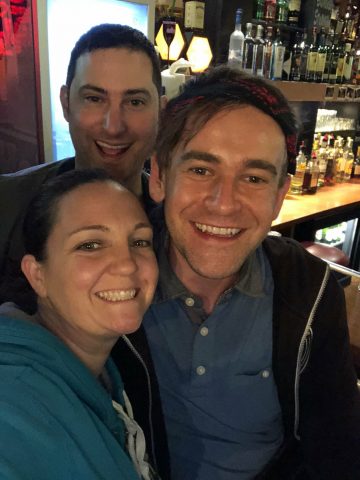 It was only a brief sojourn on the Continent, but we made the most out of it. At night we visited the city’s Red Light district and strolled the lit-up canals that reflected the tall, skinny buildings in the shimmering waters. So far, aside from the usual small travel misadventures—stumbling on the cobbled streets, or trying to get our American ATM cards to work in Dutch train ticket machines—this nostalgia-filled voyage was off to a strong start.
It was only a brief sojourn on the Continent, but we made the most out of it. At night we visited the city’s Red Light district and strolled the lit-up canals that reflected the tall, skinny buildings in the shimmering waters. So far, aside from the usual small travel misadventures—stumbling on the cobbled streets, or trying to get our American ATM cards to work in Dutch train ticket machines—this nostalgia-filled voyage was off to a strong start.
Up next: our adventures across the Mediterranean in the Holy Land.
Tags: 4 Comments





Reading your nice post from onboard the HAL Westerdam en route from Vancouver to Japan. Thanks.
Always such a pleasure to follow along with you on your travels, enjoy!
[…] I wrote in my last piece, this international foray is taking us to all the place I’d been in my earliest travels. Well, […]
Aw, this was an incredibly good post. Spending some time and actual effort to generate a great article… but what can I say… I hesitate
a lot and never seem to get anything done.